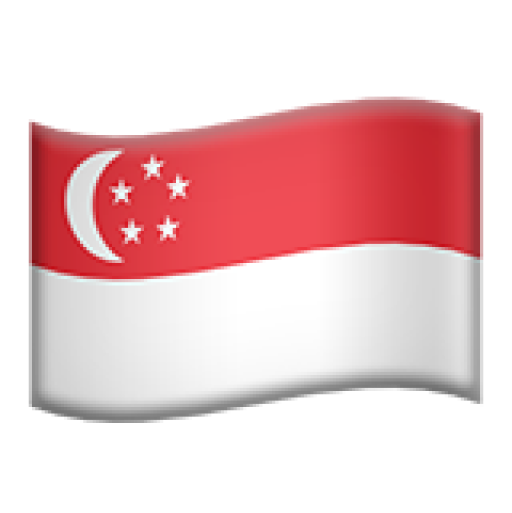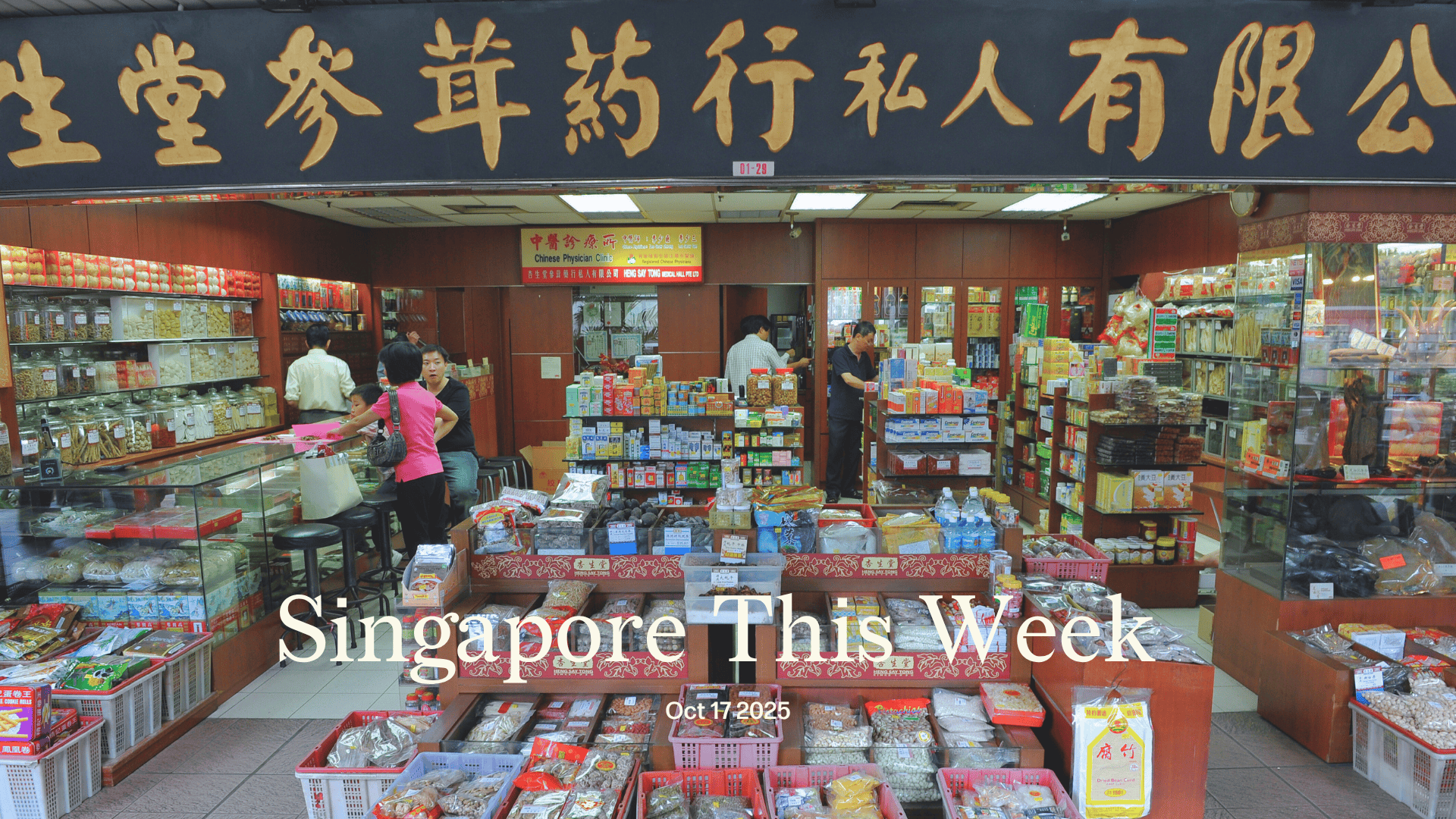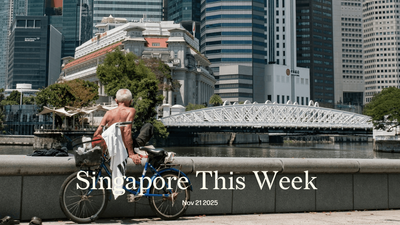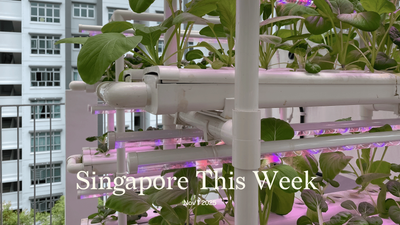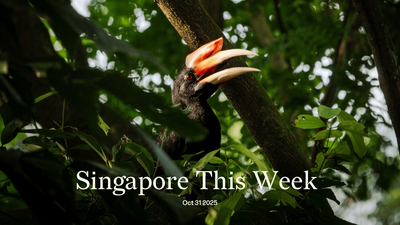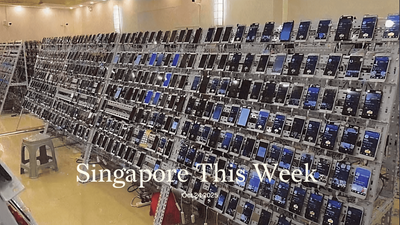Our picks
Society: May the qi be with you
Traditional Chinese medicine (TCM) thrived through self-organisation and community networks for more than a century before the Traditional Chinese Medicine Practitioners Act 2000 and the creation of the Traditional Chinese Medicine Practitioners Board (TCMPB) in 2001 gave it official standing. These moves institutionalised a hybrid legitimacy, acknowledging TCM’s cultural embeddedness while securing its place within the nation’s vision of modern, plural healthcare. “The development of Chinese medicine in Singapore is a metaphor of Singapore,” wrote Yan Yang in “A brief history of Chinese medicine in Singapore”, describing it as a fusion of East and West that embodies “the interaction of Chinese influence and the British colonial legacy.”
The latest partnership between Tan Tock Seng Hospital (TTSH) and the Nanyang Technological University (NTU) takes this hybridity further. By integrating TCM into inpatient treatment, it explores how Eastern and Western systems can complement each other in pain management, rehabilitation, and palliative care. TTSH already offers acupuncture and cupping, but practitioners hope the collaboration will lead to expanded public subsidies for traditional treatments. Only acupuncture for neck and back pain qualifies for MediSave coverage now.
In the past 18 months, TCM has re-entered the policy conversation in a serious way. The Ministry of Health is considering its inclusion into Healthier SG, the national healthcare reform plan, and is working with the TCMPB to introduce an accreditation framework for practitioners. In July, Ong Ye Kung, health minister, announced that 18 evidence-based TCM proposals will be evaluated and trialled under an integrative sandbox scheme. From 2027, final-year NTU Chinese Medicine students will also begin 13-week clinical rotations at TTSH. Licensure, ethical standards, and professionalisation will strengthen public trust and patient confidence. Technology is part of this shift: AI could soon be used to help manage diabetes or digestive issues from a TCM perspective under a new NTU-Beijing University of Chinese Medicine lab collaboration.
Local demand is also growing as TCM has gained acceptance beyond the Chinese community. According to the 2022 National Population Health Survey, one in five adult Singaporeans uses TCM services each year, and nearly 40 percent of them combine it with Western medicine. Singapore’s medical system would do well to offer greater choice, affordability, and access while enhancing safety. Doing so could expand our understanding of the human body. Not merely as an organ- and cellular-based machine, but an interconnected and interdependent system of energy, emotion and environment. Where the balance of yin and yang, “wind”, “heat”, and “dampness” become part of our lexicon of well-being.
Society: Preserving local heritage, one business at a time
Buttery soft pastry shells fried to golden-brown perfection with a filling of curried potatoes and slices of boiled eggs. Chang Chuan Boon started selling Hainanese-style curry puffs, later called “Old Chang Kee” puffs, from a Koek Road stall in 1956. Seven decades and over 70 outlets later, the company’s revamped flagship cafe on Mackenzie Road has been recognised under the National Heritage Board’s SG Heritage Business Scheme. The cafe is unmissable with its yellow accents, rattan furnishings, and an entrance decorated with local fare emerging from a split-open curry puff. Underneath, a partially drawn blind with the text: “Ah gong says…Here is where we began.”
Along with Old Chang Kee, 41 other longstanding local businesses like Swee Choon Tim Sum Restaurant, Muthu’s Curry, Toko Aljunied and CYC Company have also been recognised through the same scheme, meant to celebrate local businesses that have been “community anchors that shape the character and identity of its neighbourhood”. The criteria: they are a Singaporean business that have operated and remained in the same site or area for over 30 years; offer traditional trades, goods and/or services; demonstrate strong community ties or impact; and are committed to maintaining their heritage. Piloted in the central area, the scheme may later expand to other regions.
In a time of cultural grief and shuttering spaces, as Jom has written here and here, this is a welcome initiative. Local businesses need all the support they can get to adapt to evolving consumer behaviours and market conditions. For instance, CYC Company—a bespoke tailoring brand that has been operating since 1935—has seen demand for formal tailoring dwindle due to hybrid work arrangements and casual dressing at workplaces. Besides improving brand visibility and awareness, the scheme will support those selected with “business improvement and transformation efforts”.
But, rising rents remain one of the biggest threats facing Singaporean businesses. Many fear being priced out and replaced by large chain stores. This is a national concern. If small, independent shops disappear, we risk losing not only parts of our traditional heritage but also the everyday charm that defines heartland life: from auntie-run bubble tea stalls and void-deck mamak shops to the stylo pak cik running the neighbourhood barbershop. They all need our support. Overwhelming? Maybe start simply by shopping at the local wet market instead of a supermarket.
Society: Being immortal
Notice how supermarkets from Sheng Siong to Cold Storage now brim with lightly regulated supplements? Aisles upon aisles of syrups, pills, soft-gels, tablets, and powders to make your cells’ mitochondria move, telomeres stretch, and flagella flagellate. Or so we’re told. There’s only one, glorious aim: avoid decrepitude, delay death.
Humans have forever grappled with the idea of besting death. In “The Epic of Gilgamesh”, our earliest known story, the eponymous hero quests for immortality but eventually comes to terms with his mortality. China’s first emperor, less thinker and more drinker, consumed a mercury-laced elixir on a sorcerer’s promise of eternal life. He died. Hindu mythology has immortal beings called Chiranjivis, some cursed to walk the earth forever; others blessed to do the same. The contradiction perhaps signals our ambivalence towards immortality, equal parts hope and hubris.
No such vacillation for Silicon Valley tech bros and uncs. E-payments mogul Bryan Johnson has received plasma infusions from his teenage son, eats brown goo made from broccoli, mushrooms, and other veggies, and obsessively gets his bowels scanned. It may be working. The 45-year-old “looks approximately 43,” quipped The Guardian in 2023. Sergey Brin, Jeff Bezos, and Peter Thiel too are chucking millions in their attempts to rewrite life’s code. There’s encouragement, if they need any, from fledgling research showing that ageing may be an evolutionary adaptation–one that can in theory be overridden, much like we can override the body’s millennia-old fat storing instincts with diet, exercise, and drugs. Our homegrown, garden-variety millionaires are in on it too. Every high-net-worth individual from APAC surveyed by the bank Julius Baer said they’re pursuing longevity measures, from custom nutrition plans to cryotherapy. Forget what the philosophers told you; wealth, it seems, is health.
What hope for someone without the necessary zeroes in their bank account? Local public institutions are exploring longevity and healthy ageing or “healthspan”, for the general populace, including the Centre for Health Longevity (CHL) and the Healthy Longevity Research Clinic and the new NUS Academy for Healthy Longevity. The Academy is currently running four trials including one on the efficacy of the multivitamin and mineral supplements that supermarkets and pharmacies across the nation are hawking. “Singaporeans want to live not just longer, but better,” said Andrea Maier, co-founder and director. Of course. But even as humanity seeks to slow, halt, and even reverse ageing, the recipe for a good life hasn’t changed since Gilgamesh’s millenia-old realisation: cherish one’s time on earth; love one’s family; and eschew despair.
Politics: Beware of your neighbour
Electoral democracy globally has been poisoned by two forces: foreign interference, such as Beijing meddling in Taiwan last year; and rising nativism and identity politics, from Budapest and Catalonia to Washington, DC. Though not to be taken for granted, Singapore is relatively immune to them. Why? Establishment folk will probably credit the policing of society by the ruling People’s Action Party (PAP). Other factors include demography. Singaporeans are largely urban, middle-class, and comfortable with a multicultural existence (as evidenced by how our foods fused, long before the PAP was around). Contrary to establishment perception, we’re more homogenous, in many ways, than other large democracies (think KL to Hulu Perak). Political appeals to fragmented, nebulous “identities” here are trickier. Meanwhile, major Singaporean parties are broadly aligned on foreign policy—unlike, say, in Taiwan—dampening the allure of interference.
So when the PAP warns about them, as K Shanmugam, coordinating minister for national security, did this week, it’s important to ponder why. One incident at GE2025 involved Noor Deros, an Islamic preacher who made demands of political parties; said he’d met Malay candidates from the Workers’ Party (WP); and called on Tampines voters to choose the WP’s Faisal Manap (and his team) over the PAP’s Masagos Zulkifli (and his). The other concerned two politicians from Malaysia’s Parti Islam Se-Malaysia (PAS), who had, respectively, supported Faisal and criticised the PAP’s own Malay Muslim candidates. (The government blocked their social media accounts.)
It was a matter of days from Noor’s post to the WP’s repudiation of it and foreign interference, following a government statement. Shanmugam took issue with the WP’s apparent lackadaisical response. “If this is not done immediately, clearly and unequivocally, it will give rise to questions; confusion.” Pritam Singh, WP chief, claimed that Noor had gate-crashed a meeting with other Islamic leaders; and that he was wary of giving a “nobody” airtime. Shanmugam, at his lawyerly best, focused on the minutiae of statements and their timings, and extracted from Singh an admission that the WP could have been “clearer”.
Shanmugam argued that “the lack of clear response, a vague response, must have been a deliberate choice based on a calculation of interest”. Expect this line of attack to continue: WP = identity politics and stooges of foreigners. It’s nothing new. In the late 1990s, the PAP accused the WP’s Tang Liang Hong of Chinese chauvinism. In 2017, Masagos criticised Faisal for raising the “divisive issue” of female Malay nurses and officers being allowed to wear the tudung. (Then in 2021, the PAP relented and allowed it.) Shanmugam also criticised Damanhuri Abas, politician with the Singapore Democratic Party (SDP), for appealing to the Malay ground during the election; but then later, responding to a question, said it’s “perfectly acceptable” for political parties to say that their policies will benefit a specific community, and “entirely possible” that parties might argue over who best protects minority interests. It’s unclear where the line is.
Shanmugam also rejected a more “open fora” to discuss racial and religious issues, pointing to the experiences of Western liberal democracies. Therein lies the main philosophical difference between conservatives and progressives. After decades of darkness on a taboo issue, we believe an opening up is necessary in order for society to mature. We’re far from any imagined slippery slope to racial conflict. The PAP should trust Singaporeans more.
Politics: The foreigner we like
All hail the Polish king who’s endeared himself to the PAP by demeaning its critics. This week saw his finest hour, his name exalted in Parliament, and his “commentaries”—right-wing abuse and vitriol at its best—defended, on the grounds that they’re similar, apparently, to those from the world’s leading newspapers.
Kenneth Tiong of the WP pointed to Michael Petraeus’s “racially charged commentary” on his platform, Critical Spectator, including a piece titled, “WP abandons Muslim voters, turns to the Chinese”.* Just as Shanmugam had asked the WP to respond decisively to Noor and others, “Will the PAP categorically reject and disavow his support today?” Tiong asked.
Shanmugam responded that many others run commentaries on Singapore, including The Economist, The New York Times, and the South China Morning Post. Petraeus’s work, Shanmugam said, “does not amount to, within the definition, interfering in local politics.” Technically, unless Petraeus actively interferes in electoral politics, that’s probably correct. Though it reflects a misunderstanding of modern media. The most important difference is that international newspapers are writing for an international audience—not seeking to build a commercial business by influencing a local one, as Petraeus clearly is. Others include transparency on funding and ownership, and rigorous editorial oversight by boards.
Shanmugam’s reluctance to reject Petraeus’s racially-charged narratives sets a dangerous precedent. As a thought experiment, would the following commentaries be tolerated in Singapore?
“PAP abandons Palestinian sympathisers, turns to pro-Israelis”, by a Palestinian.
“PAP abandons Born-Again-Chinese, turns to Born-Again-Trumpians”, by a YouTuber from Beijing.
“PAP abandons Muslim voters, turns to the Chinese,” by a Malaysian blogger.
There is one thing to respect about Michael Petraeus. Unlike other PAP-loving trolls, keyboard warriors who hide behind pseudonyms like Singapore Matters, at least there is authenticity with him: a face and name to the writing. No wonder the party cherishes him.
* The commentary’s full title, incidentally, is “WP abandons Muslim voters, turns to the Chinese with its NCMP pick, heeding advice from Terry Xu”. Petraeus has criticised Tiong for omitting the second part, but it’s the sensationalist opening, what Tiong highlighted in Parliament, that’s the crucial weapon in the clickbait arsenal of a troll.
Politics: Self-help with Chee Soon Juan
“There were nights I sat alone in the dark, long after the noise had faded, wondering if it was all worth it…But I am still here. I am still standing. And I want to tell you why.” Thus begins Unbroken: The Power of Resilience, the eleventh book by one of Singapore’s most prolific authors, Chee Soon Juan. (One was co-authored with his wife, Huang Chih Mei.) Unlike his previous ones, the SDP secretary-general has eschewed policies and platforms for a blend of introspection and mental health advice, all told in snappy prose, numbered lists, and bullet-points. This is less Chee the politician than Dr Chee the neuropsychologist.
There’s sufficient background for readers unfamiliar with how the system ostracised and demonised him after he joined the opposition. Chee was kicked out of NUS for seemingly trivial expense claims; had a consultancy position at Mount Elizabeth Hospital scuttled by “shadow phone calls” to its American CEO; imprisoned; and was forced to sell the family’s terrace house to pay his mounting legal bills. Through it all, politicians and journalists repeatedly smeared him. “During the elections in 1997, I became the centre of hate and harassment: Our dog was poisoned; the power circuitry to our house was cut; our car tyres were repeatedly slashed; and anonymous, threatening calls punctuated the nights.”
Interspersed with memoir is neuroscience. We learn, for instance, that the anterior cingulate cortex, an emotion regulator shown in one of several textbook-like visuals, is activated when a person feels rejected. “When we are ostracised, our brain responds as if we are being physically harmed.” There is a broad self-help lexicon here: growth mindsets; the importance of relationships, purpose, and a moral compass; numerous ways to understand the concept of “resilience”; and techniques like journalling through expressive writing. There are supporting quotes and anecdotes from psychologist Carol Dweck, philosopher Han Byung-Chul, Nelson Mandela, Niccolò Machiavelli, and AirBnB’s Brian Chesky, among many others. And there is the story of how Chee and the SDP have soldiered on and evolved over the past few decades.
Expectedly, there’s much information on our mental health crisis, one of the party’s key interest areas. The analysis dovetails well with his personal experience. Establishment folk trying to understand Chee’s appeal and his persistence will find some answers here, not all encouraging if they hope he’ll wither away after seven failed elections. “For me, the turning point wasn’t some grand revelation. It was remembering this: I do not need to be whole to be worthy. I do not need to be strong to continue.”
Note: Unbroken: The Power of Resilience is available direct and in select bookstores.
History weekly with Abhishek Mehrotra
London, 1882. Inside an unremarkable stone building, blazing black rocks turn water into captive steam. Angry and hissing, it races through pipes, spinning a turbine with gathering ferocity. At the turbine’s end, like a dervish in a fever dream, a magnet whirls within copper coils, summoning a powerful, invisible force. In moments, a thousand bulbs light up the street outside. Electricity, from the world’s first coal-fired power station.
Across the English Channel, Frenchman Augustin Mouchot is convinced that coal will one day run out. “What will industry do then?” The answer, he believes, lies not in the earth, but the sky. Mouchot uses mirrors to boil water from sunlight; its steam powers a small engine. But solar is too costly for a world enamoured with cheap soot.
Singapore joins the current in 1905 when the Singapore Electric Tramways opens its coal-fired power plant, selling surplus electricity to the municipality. The first streetlights come a year later. But the “fishing village”, growing and hungry, needs more. The shoreside St. James’ power station opens in 1926; cooled by seawater and fuelled by coal from Sumatra and Kalimantan. By 1965, oil and natural gas join coal in powering Singapore and the world. They bring unprecedented prosperity.
Solar is still around. Researchers at Bell Labs build on Mouchot’s ideas and Albert Einstein’s Nobel Prize winning work on the photoelectric effect to create more efficient solar cells. Some power an instrument Neil Armstrong and Buzz Aldrin leave on the moon in 1969. Back on earth, an environmental movement is brewing. The first Earth Day is in 1970; at the first UN Conference on the Human Environment in 1972, developing nations—“newcomers to contamination,” The Straits Times (ST) calls them—acknowledge that human action is linked to environmental degradation. Singapore upgrades its Anti-Pollution Unit to an Environment Ministry that same year even as Chua Sian Chin, health minister, avers that development and the environment are not antagonists. But the needle shifts. The Intergovernmental Panel on Climate Change (IPCC); the Kyoto Protocol; and the Paris Agreement are all signs of a world slowly (too slowly, perhaps) coming to terms with climate change.
Policy and normative shifts spur technology. Germany and Japan incentivise domestic solar power even as activists denounce “dirty coal”. By millennium’s turn, China is making huge investments in solar. By the 2010s, decades of efforts drive costs down, way down, even below coal, in most countries. Last week, an energy think tank confirms the news: this year, for the first time in history, the world has generated more electricity from renewables—mostly from solar—than from coal.
Arts: Glamping for guai kias
With those pesky PSLEs finally in the rearview mirror, and the long, lazy horizons of November and December ahead—what new schemes and schedules might parents be plotting for their tweens and teens? Fret not. Two arts groups have done the planning for you. Literary nonprofit Sing Lit Station will be running their annual creative writing holiday camp in November. The plot twist: the three-day camp is themed around mystery and crime thrillers. Participants will learn how to worldbuild not just through writing; they’ll also craft characters through murder-mystery and tabletop roleplaying games. You might find local writers Suffian Hakim in the Library wielding a Pen, or Neil Humphreys in the Lobby armed with a Laptop. Then there’s Camp-O, by socially-engaged theatre company Drama Box, which returns in December with a five-day programme blending games, improvisation exercises and group activities. The camp’s fundamentals are drama, sound and movement, upon which participants will build their confidence in creative expression as they explore conflict and dramatic tension, rhythm and duration, and bodily awareness and creative choreography. It’s holistic development for wholesome kids. “I liked the really fun games that really spiced up the camp and the wholesome company I had 🥰🥺,” one former CampLit participant declared.
But if this is where all the good kids go, is there any room for the rebels? For all you former pai kias, there’s another place for you, and that’s “The Serangoon Gardens Techno Party of 1993”. This R18 play by Joel Tan—himself an occasional DJ—features a bougie teen who goes on an all-night bender through 1990s Singapore as a sort of metaphorical middle finger to her morally panicky mother. It’s an era when the straitlaced city-state harboured dreams of letting loose without actually letting go. Over the course of the evening, our protagonist slash rebel wannabe gets tangled up with punks, the police, and a particularly persuasive white boy. Tan, the “churchy” well-behaved kid growing up, and who only began to revel in his rebellious side in his 30s, considers this “ill-behaved” play “an elaborate act of wish fulfilment”. He told ST, “It actually breaks my heart to see young people who don’t want to get f***ed up. The guai kia (Hokkien for ‘well-behaved kids’) have won.” It opens tonight. Whether guai kias wanting to live it or pai kias wanting to relive it, all are welcome.
Abhishek Mehrotra, Sakinah Safiee, Corrie Tan, Tsen-Waye Tay, and Sudhir Vadaketh wrote this week’s issue.
If you enjoy Jom’s work, do get a paid subscription today to support independent journalism in Singapore.

